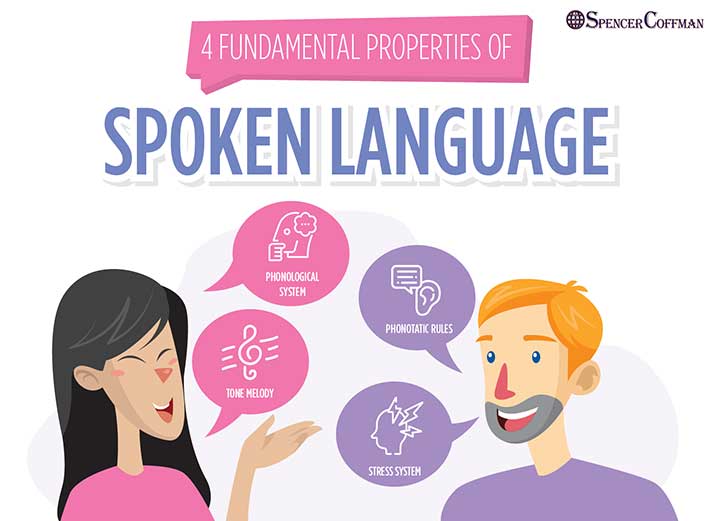We all speak many words every day without thinking about what goes into all of those words. Language is truly an amazing thing. It is made up of so much more than we will ever be able to understand. If you’ve been following my articles then you know several of these components that make up a language.
We’ve gone over learning methods, learning strategies, language theory, and more. Today we are going to take a look at four fundamental properties of spoken language. In other words, the things that make up all of the words we speak.
First Property
The Phonological System is the first property of spoken language and it consists of the smallest units of sound. For example, the individual letters that form a syllable. These are the sounds that many children learn when they are starting to learn a language. It is the “phonics” or “letter sounds” of a language.
In addition, the phonological system is also concerned with how those letter sounds change within words. Is the ‘A’ in cat a long ‘A’ or a short ‘A’? What happens when two vowels go walking? Et cetera. Many individuals dedicate their careers to studying these sounds within several languages. This practice is called phonology or the study of individual units of sound.
Second Property
Phonotactic Rules is the second property of language and it is a level up from the phonological system. While the phonological system is mostly concerned with the individual sounds within words, phonotactics are concerned with the arrangements of those sounds and how they compose syllables of meaning.
In other words, they are not only concerned with syllables but the meanings behind those syllables. For example, the prefixes and suffixes of a language are syllables added to words to change the meaning or context of those words. Predetermined is different than determined and determined is different that determine.
All of those words come from the same root of determine but when ‘pre’ or ‘ed’ are added, the meaning of the word changes. Once again, there are teams of people dedicated to studying these relationships not only within a single language but also within multiple languages as a whole. This practice is called morphology because they are studying how added syllables are morphed onto existing words.
Third Property
The third fundamental property of spoken language is called Tone Melody. Tone melodies are changes in pitch and how these changes affect the meanings of words or sentences. Anytime people talk, their voices change in pitch and those changes can connotate different meanings.
For example, in the English language when someone says a sentence without a question prefix like how, what, when, et cetera it can still be a question if they add a rising intonation at the end of the sentence. The only way you would know that it is a question is because of the rising intonation.
If you were to merely read their statement then it wouldn’t look like a question because it is only a statement and doesn’t have any questioning words. The same is true for emotions. Lots of emotion can be added to words depending upon how they are emphasized.
Fourth Property
The fourth property is known as the Stress System. Similar to how the first two properties are a level up from each other, the stress system is a level up from tone melody. It determines the way in which changes in pitch combine with sounds. It is essentially a combination of tone melody and the phonological system.
Where tone melody is mainly concerned with the inflections and tones and the phonological system is mainly concerned with the individual sounds themselves, the stress system is concerned with how the inflections are applied to the sounds in words. They are the rules for applying stress to the words in sentences and are often expressed in italics when in written form.
Learn How To Reduce Stress Now!
Wrapping Up
In relation to each other, the components of the phonological system form meaningful sounds based on the phonotactic rules. The rules make up the format for how the sounds fit together to form words that carry meaning. The tone melodies attach themselves to these meaningful word sounds based on the rules of the stress system.
The stress system also adds additional meaning based upon how certain words are emphasized. All four of these properties interact with one another to produce a complete language structure. Though we may not think about all of the detailed information that makes up a language, it is definitely an advanced and complex means of communication.
For more great information take a look at the supplemental content on this website and check out these great blog posts. In addition, feel free to connect with me on social media.





